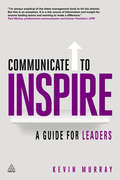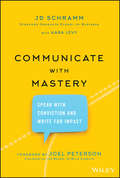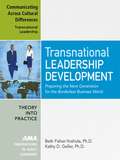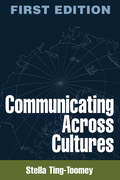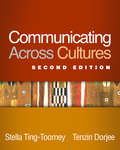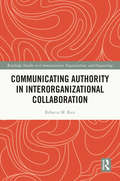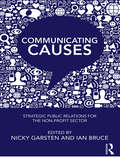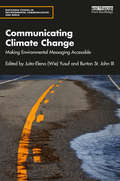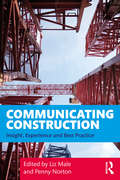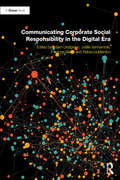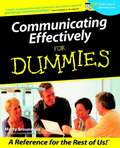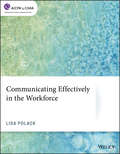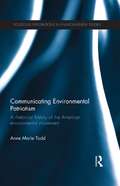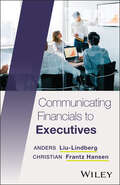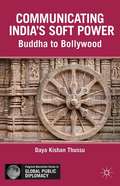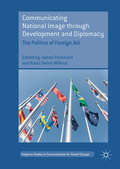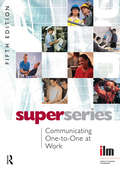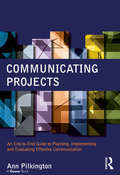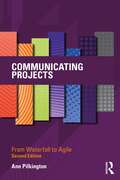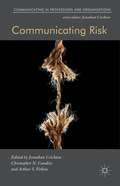- Table View
- List View
Communicate to inspire
by Kevin MurrayCommunicate to Inspire answers some of the key practical questions for becoming a better leader, such as: "How do you learn to be yourself, better?" and "What should you examine and how should you articulate your own purpose and values?" Kevin Murray presents a model that charts the leadership process and draws stories from his experience coaching leaders. This book offers principles of leadership communication that address: how to become more audience-centric; how to emphasize values; how to focus on the people leaders need to inspire; what methods and tools to use to try to see the world through their eyes and address their needs; and mastering the art of public speaking. Communicate to Inspire uses charts and information gathered from dozens of successful training programs to determine how to turn a department, division or company into a better listening, faster responding, more innovative entity, just by holding more and better structured conversations.
Communicate with Courage: Taking Risks to Overcome the Four Hidden Challenges
by Michelle D GladieuxConfront the psychological blocks that are holding you back—and become a fearless and peerless communicator. Winner of the 2023 PenCraft Best Book Award for Nonfiction, 2023 Nonprofit Authors Association Silver Award, 2023 Readers&’ Favorite Bronze Medal Award for Business, and 2023 Dan Poynter&’s Global Ebook Gold Award for Communications As a lifelong communication coach, Michelle Gladieux has discovered the four sneaky obstacles that can keep you from becoming an effective communicator:Hiding—Fearing your low self-confidence will expose your supposed weaknessesDefining—Putting too much stock into your assumptions and being quick to judge right and wrongRationalizing—Using &“being realistic&” to shield yourself from taking chances, engaging in conflict, or doing other scary but potentially rewarding actionsSettling—Stopping at good enough instead of pushing for something better What all these challenges have in common is they require taking risks—to reveal yourself, to question your beliefs, to take a leap of faith, or to move out of your comfort zone. As a response, each chapter includes a Pro Move, or a best practice, and an exercise designed to help you overcome your fears and become a powerful communicator. Courageous communication requires self-knowledge, practice, and a fierce desire to continually improve; this book is like having an expert coach along with you for every step of the journey. &“[A] wonderful book.&” —Karl W. Einolf, PhD, President, Indiana Institute of Technology
Communicate with Mastery: Speak With Conviction and Write for Impact
by JD SchrammDevelop your leadership communication Communicating with Mastery provides readers with a rich treasure trove of frameworks and tools for leadership communication as developed and taught over the past decade at Stanford's Graduate School of Business. Designed for the business leader on the go, it provides you quick access to helpful approaches to vexing communication problems leaders face today in speaking and writing to various audiences. Projects often fail not because of the vision, but in the articulation of that vision. With the help of this book, you’ll learn how to ensure you get the results you desire as a leader and communicator including: Speak with conviction and write with impact Tailor your communication to any goal, setting, or audience Scale your leadership through effective coaching Every time you write or speak, you need to make your words count. And this book shows you how.
Communicate--with Care: How to Be a More Effective Leader
by Gareth Jones Rob GoffeeEffective leaders pay careful attention to how they are seen and heard. This chapter explores the ways in which leaders construct compelling narratives about themselves and their contexts, and the ways in which they identify the channels of communication that work best for them.
Communicating Across Cultural Differences: Transnational Leadership
by Beth Fisher-Yoshida Kathy D. GellerThis chapter from Transnational Leadership Development teaches how to communicate across cultures focusing on the interaction between the speakers (direct–indirect), the shared and disparate meaning of words, expressions, and phrases (words–expressions), and to the style of delivering the message (linear–circular). Filled with examples it features a model for communicating more effectively across cultural differences including listening more effectively, forms of inquiry, voicing thoughts and feelings, and empathy.
Communicating Across Cultures
by Stella Ting-ToomeyFrom high-level business negotiations to casual conversations among friends, every interpersonal interaction is shaped by cultural norms and expectations. Seldom is this more clearly brought to light than in encounters between people from different cultural backgrounds, when dissimilar communication practices may lead to frustration and misunderstanding. This thought-provoking text presents a new framework for understanding the impact of culture on communication and for helping students build intercultural communication competence. With illustrative examples from around the globe, the book shows that verbal and nonverbal communication involves much more than transmitting a particular message it also reflects each participant's self-image, group identifications and values, and privacy and relational needs. Readers learn to move effectively and appropriately through a wide range of transcultural situations by combining culture-specific knowledge with mindful listening and communication skills. Throughout, helpful tables and charts and easy-to-follow guidelines for putting concepts into practice enhance the book's utility for students.
Communicating Across Cultures, Second Edition: Esl Learners In The Non-esl Classroom (The\guilford Communication Ser.)
by Stella Ting-Toomey Tenzin DorjeeThis highly regarded text--now revised and expanded with 50% new material--helps students and professionals mindfully build their knowledge and competencies for effective intercultural communication in any setting. The authors' comprehensive, updated theoretical framework (integrative identity negotiation theory) reveals how both verbal and nonverbal communication are affected by multilayered facets of identity. Written in a candid, conversational style, the book is rich with engaging examples illustrating cultural conflicts and misunderstandings that arise in workplace, educational, interpersonal, and community contexts. Readers learn how to transform polarized conversations into successful intercultural engagements by combining knowledge about culture with mindful listening and communication skills. New to This Edition *Extensively revised to reflect the ongoing development of integrative identity negotiation theory, nearly 20 years of research advances, the growing diversity of the United States, and global trends. *Chapter providing a mindfulness lens on intercultural and intergroup communication competence. *Chapter on culture shock in sojourners (international students, global businesspeople, and others). *Chapter on immigrants' acculturation processes. *Lively chapter-opening case examples, including compelling personal stories from the authors and others from diverse cultures. *End-of-chapter summaries, "Mindful Guidelines" to put into practice, and critical thinking questions. *New and expanded discussions of hot topics: cross-cultural workplaces, community building, peace building, romantic relationships, prejudice and discrimination, microaggressions, and ethical issues.
Communicating Authority in Interorganizational Collaboration (Routledge Studies in Communication, Organization, and Organizing)
by Rebecca M. RiceThe book offers an in-depth analysis of the challenges of establishing authority within collaborative efforts. It introduces the concept of cumulative authority, arguing that communicating authority effectively is key to the creation and success of collaborations. Rice uses a communication-as-constitutive of organizations perspective to reconsider organizational authority, typically thought of in terms of leadership, as instead negotiated in communication among collaboration members as they attempt to influence the collaboration’s direction. Drawing from an extensive two-year case study of emergency management collaborations, the book traces potential influences on collaborative authority, including members’ knowledge and expertise, organizational structures and hierarchies, and the material world, including documents, technologies, and the natural environment. This book is a valuable empirical resource for organizational communication and management students and scholars. It will also appeal to community collaborators and organizers, and contains advice and reflection questions for practitioners.
Communicating Causes: Strategic public relations for the non-profit sector
by Ian Bruce Nicky GarstenNon-profit organizations (NPOs) across the world are facing criticism alongside approbation. In order for NPOs to effectively support their causes, they require public trust. The editors of this book have persuaded PR experts from the UK and around the world, from a variety of PR specialisms operating across different organizational forms, to share their knowledge and experience. These contributions are scaffolded with authoritative academic and practical advice, as well as solutions. The book starts with foundations that underpin communications for causes. These include arguments that support the importance of non-profits in civil society; lessons in corporate governance; and a new approach to issues management. PR planning subjects tailored, or specific, to the sector include: strategic global communications planning, agile digital communications; branding internal communications and the securing of meaningful outcomes. Corporate partnerships are examined with a new ‘Fit to Partner Test’ and consideration of the mandated corporate social responsibility (CSR) in India, corporate volunteering in Brazil, and CSR in South Africa. Relations between governments and non-profits are also considered, both generally and with a particular focus on China. Communicating Causes looks at effective strategy and practice of PR in the modern non-profit. Including forewords by both John Grounds and Jon Snow, the expert perspectives offered in this book provide valuable support to current and future communicators.
Communicating Clearly about Science and Medicine: Making Data Presentations as Simple as Possible ... But No Simpler
by John ClareScientific communication is challenging. The subject matter is complex and often requires a certain level of knowledge to understand it correctly; describing hazard ratios, interpreting Kaplan Meier curves and explaining confounding factors is different from talking about a new car or clothing range. Processes, for example in clinical trials, are laborious and tedious and knowing how much of the detail to include and exclude requires judgement. Conclusions are rarely clear cut making communicating statistical risk and probability tough, especially to non-statisticians and non-scientists such as journalists. Communicating Clearly about Science and Medicine looks at these and many more challenges, then introduces powerful techniques for overcoming them. It will help you develop and deliver impactful presentations on medical and scientific data and tell a clear, compelling story based on your research findings. It will show you how to develop clear messages and themes, while adhering to the advice attributed to Einstein: 'Make things as simple as possible...but no simpler.' John Clare illustrates how to communicate clearly the risks and benefits contained in a complex data set, and balance the hope and the hype. He explains how to avoid the 'miracle cure' or 'killer drug' headlines which are so common and teaches you how to combine the accuracy of peer-to-peer reviewed science with the narrative skills of journalism.
Communicating Climate Change: Making Environmental Messaging Accessible (Routledge Studies in Environmental Communication and Media)
by Juita-Elena Wie Yusuf And Burton St. John IIIThis edited collection focuses on theoretical and applied research-based observations concerning how experts, advocates, and institutions make climate change information accessible to different audiences. Communicating Climate Change concentrates on three key elements of climate change communication – access, relevance, and understandability – to provide an overview of how these aspects allow multiple groups of stakeholders to act on climate-related information to build resilience. Featuring contributions from a wide range of scholars from across different disciplines, this book explores a multitude of different scenarios and communication methods, including social media; public opinion surveys; participatory mapping; and video. Overall, climate change communication is addressed from three different perspectives: communicating with the public; communicating for stakeholder engagement; and organizational, institutional, risk, and disaster communication. With each chapter focusing on implications and applications for practice, this book will be of great interest to students and researchers of climate change and environmental communication, as well as practitioners interested in understanding how to better engage stakeholders through climate change-related communication.
Communicating Climate-Change and Natural Hazard Risk and Cultivating Resilience: Case Studies for a Multi-disciplinary Approach (Advances in Natural and Technological Hazards Research #45)
by Jeanette L. Drake Yekaterina Y. Kontar John C. Eichelberger T. Scott Rupp Karen M. TaylorThis edited volume emphasizes risk and crisis communication principles and practices within the up-to the minute context of new technologies, a new focus on resiliency, and global environmental change. It includes contributions from experts from around the globe whose research, advocacy, teaching, work, or service in the natural or social sciences deals with risk communication and/or management surrounding natural and technological disasters, with a particular focus on climate change-related phenomena. Resilience and good communication are intimately linked and with climate change precipitating more numerous and onerous weather-related catastrophes, a conversation on resilience is timely and necessary. The goal is robust communities that are able to withstand the shock of disaster. Communicating well under ordinary circumstances is challenging; communicating during a crisis is extraordinarily difficult. This book is dedicated to all those who have directly or indirectly suffered the effects of climate change end extreme events with the hope that the advance of knowledge, implementation of sound science and appropriate policies and use of effective communication will help in reducing their vulnerability while also improving resilience in the face of often devastating natural and technological disasters.
Communicating Construction: Insight, Experience and Best Practice
by Liz Male and Penny NortonThis book is a wide-ranging exploration of PR and communication in the construction industry, with a strong emphasis on communications theory, strategy and technique. The editors begin with an introduction to the UK construction industry and its supply chains, as well as various elements of PR in relation to the construction process. Subsequent chapters provide a strategic overview, practical examples, success stories, case studies and personal perspectives on PR for different parts of the built environment and reputational issues in construction. Chapters include expert advice on communications for architecture, planning, building consultancy, building products and manufacturers, general and specialist contractors, construction technology, infrastructure and communicating sustainability in the built environment. The conclusion looks at the current and upcoming reputational priorities for communicators in construction, as well as the top ten priorities for implementing PR as a strategic management discipline in the industry. This book is essential reading for all construction PR teams, students studying both for built environment and PR/marketing degrees and CPD courses, and anyone working in the built environment sector who needs to consider PR and marketing as part of their role.
Communicating Corporate Social Responsibility in the Digital Era
by Adam Lindgreen Joelle Vanhamme Rebecca Watkins Francois MaonAlthough literature on corporate social responsibility is vast, research into the use and effectiveness of various communications through digital platforms about such corporate responsibility is scarce. This gap is surprising; communicating about corporate social responsibility initiatives is vital to organizations that increasingly highlight their corporate social responsibility initiatives to position their corporate brands for both consumers and other stakeholders. Yet these organizations still sometimes rely on traditional methods to communicate, or even decide against communicating at all, because they fear triggering stakeholders’ skepticism or cynicism. A systematic, interdisciplinary examination of corporate social responsibility communication through digital platforms therefore is necessary, to establish an essential definition and up-to-date picture of the field. This research anthology addresses the above objectives. Drawing on marketing, management, and communication disciplines, among others, this anthology examines how organizations construct, implement, and use digital platforms to communicate about their corporate social responsibility and thereby achieve their organizational goals. The 21 chapters in this anthology reflect six main topic sections: Challenges and opportunities for communicating corporate social responsibility through digital platforms. Moving toward symmetry and interactivity in digital corporate social responsibility communication. Fostering stakeholder engagement in and through digital corporate social responsibility communication. Leveraging effective digital corporate social responsibility communication. Digital activism and corporate social responsibility. Digital methodologies and corporate social responsibility.
Communicating Effectively For Dummies (For Dummies Ser.)
by Marty BrounsteinCommunicating Effectively For Dummies shows you how to get your point across at work and interact most productively with bosses and coworkers. Applying your knowledge and skill to your job is the easy part; working well with others is often the hard part. This helpful guide lets you maximize your personal interactions, even when resolving conflicts, dealing with customers, or giving difficult presentations. Whether you’re the CEO of a major corporation, a small business owner, or a team manager, effective and clear communication is imperative to your success. From keeping your listener engaged to learning to become a better listener, Communicating Effectively For Dummies offers all the strategies, tips, and advice you need to: Learn how to become an active listener Accentuate the positive in negative situations Find win-win solutions for conflicts Stay on track when writing e-mails and letters Handle presentations, interviews, and other challenges Speak forcefully and assertively without alienating others Management consultant Marty Brounstein — author of Handling the Difficult Employee and Coaching and Mentoring For Dummies — gives you the keys to a thriving career with expert advice on effective verbal and nonverbal communication. From mastering your own facial expressions (and reading them in others) to being a happy boss, Brounstein covers all the angles: Becoming aware of your own assumptions Dealing with passive-aggressive communicators What to say to help someone open up to you Communicating through eye contact and body language Maintaining a positive attitude Dealing with sensitive issues Effective conflict resolution models When to use e-mail, the phone, or a face-to-face meeting Dealing with angry customers Coaching your staff to communicate better In today’s high-stress work environment, good communication skills are imperative for keeping your cool and getting your point across. Knowing what to say and how to say it, as well as being a good listener, can often be the difference between getting ahead and just getting by. This handy, friendly guide shows you how to avoid common conflicts and make your voice heard in the office.
Communicating Effectively in the Workforce (AICPA)
by Lisa PolackIf you do not understand how communication works, then you may become perplexed and frustrated by interactions in the workplace. However, if you understand how communication works, then you have a good chance of diagnosing and fixing communication problems. Best of all, you can influence and motivate your employees, make better decisions, negotiate more effectively, build better work teams, and accomplish business objectives. This book discusses the various forms of communication.
Communicating Environmental Patriotism: A Rhetorical History of the American Environmental Movement (Routledge Explorations in Environmental Studies)
by Anne Marie ToddEnvironmental patriotism, the belief that the national environment defines a country’s greatness, is a significant strand in twentieth century American environmentalism. This book is the first to explore the history of environmental patriotism in America through the intriguing stories of environmental patriots and the rhetoric of their speeches and propaganda, The See America First movement began in 1906 with the aim of protecting and promoting the landscapes of the American West. In 1908, Gifford Pinchot and President Theodore Roosevelt hosted the White House Conservation Conference to promote the wise use of natural resources for generations of Americans. In 1912, Pittsburgh’s smoke investigation condemned the effects of coal smoke on the city’s environment. In World War II, a massive propaganda effort mobilized millions of Americans to plant victory gardens to save resources for the war abroad. While these may not seem like crucial moments for the American environmental movement, this new history of American environmentalism shows that they are linked by patriotism. The book offers a provoking critique of environmentalists’ communication strategies and suggests patriotism as a persuasive hook for new ways to make environmental issues a national priority. This original research should be of interest to scholars of environmental communication, environmental history, American history and environmental philosophy.
Communicating Financials to Executives
by Anders Liu-Lindberg Christian Frantz HansenPractical guide to effectively communicate financial data, ideas, and insights to executives Communicating Financials to Executives delivers indispensable insights on how to clearly, effectively and productively communicate financials to executives across industries in an influential manner. In this book, finance practitioners and consultants Anders Liu-Lindberg and Christian Frantz Hansen deliver a five-step approach on how to get started, along with underlying theory explaining why each step is imperative to success. Special attention is placed on not just presenting data but doing so in a way that brings significant value to the table and creates an impact that leads to greater business success for the organisation. Topics explored in this book include: The executive decision-making process and how to tailor your approach to seamlessly integrate into it Managing the amount of detail in communications and knowing how to structure data appropriately Visual elements that can help better communicate data to individuals who aren't “numbers people” Specific struggles that financial and accounting professionals face in the modern business environment How to build management reports that are easily understood by executives and drive significant business value Communicating Financials to Executives earns a well-deserved spot on the bookshelves of all finance professionals seeking to better harvest the fruits of their labour by properly articulating ideas and insights to decision-makers within an organisation.
Communicating India’s Soft Power
by Daya Kishan ThussuIn recent years, India has emerged as a major economic and political power. Yet, the country's cultural influence outside India has not been adequately analyzed in academic discourses. This book, a pioneering attempt, from an international communication/media perspective, is aimed to fill the existing gap in scholarship in this area.
Communicating National Image through Development and Diplomacy: The Politics of Foreign Aid (Palgrave Studies in Communication for Social Change)
by Karin Gwinn Wilkins James PammentThis edited collection draws upon interdisciplinary research to explore new dimensions in the politics of image and aid. While development communication and public diplomacy are established research fields, there is little scholarship that seeks to understand how the two areas relate to one another. However, international development doctrine in the US, UK and elsewhere increasingly suggests that they are integrated–or at the very least should be–at the level of national strategy. This timely volume considers a variety of cases in diverse regions, drawing upon a combination of theoretical and conceptual lenses that combine a focus on both aid and image. The result is a text that seeks to establish a new body of knowledge on how contemporary debates into public diplomacy, soft power and the national image are fundamentally changing not just the communication of aid, but its wider strategies, modalities and practices.
Communicating National Integration: Empowering Development in African Countries
by Osabuohien P. AmienyiThis book addresses the negative impact of social cleavages on the development of many African countries. It proposes new ideas on how the development crisis in Africa may be addressed by conceptualizing the underlying problem as a communication issue. In contrast to the frequent neglect of this key factor this book provides a provocative discussion of how communication strategies can help to promote national integration and social, economic and political development. It argues that the activities associated with the communication of national integration must be seen as an all-encompassing task that transcends official speeches in attempts to persuade a disparate population to cultivate national consciousness. Such activities must encompass efforts to persuade leaders to eliminate policies that seek to promote spatial dislocation and cross-cultural interaction, and to arouse the audience to pay closer attention to integrative messages disseminated through the mass media.
Communicating One-to-One at Work (Institute Of Leadership And Management Ser.)
by Institute of Leadership & ManaSuper series are a set of workbooks to accompany the flexible learning programme specifically designed and developed by the Institute of Leadership & Management (ILM) to support their Level 3 Certificate in First Line Management. The learning content is also closely aligned to the Level 3 S/NVQ in Management. The series consists of 35 workbooks. Each book will map on to a course unit (35 books/units).
Communicating Projects: An End-to-End Guide to Planning, Implementing and Evaluating Effective Communication
by Ann PilkingtonEvery programme and project manager knows that they need interaction and engagement to be truly effective, but their understanding of what good communication looks like can vary. All too often people are put into communication roles without the necessary skills or experience. Whilst there are many texts on public relations and an increasing number on internal/employee communication, programme and project communication spans a number of disciplines and has its own requirements. Communicating Projects gives programme and project communicators a framework for developing an effective strategy that goes well beyond inter-programme/project communication and looks at how to achieve behaviour change and even increase employee engagement through the process. The book follows a best practice model for communication strategy development and planning. The model is supplemented with vignettes that explore communication concepts in more detail (for example employee engagement, communication theory and persuasion). At the same time, the text follows the project lifecycle with the appropriate approaches for initiation, development and delivery stages outlined. If you accept the crucial role communication plays in securing project success then this book is a must-have guide for any project manager or anyone tasked with stakeholder engagement.
Communicating Projects: From Waterfall to Agile
by Ann PilkingtonThe communication of projects to each stakeholder group is essential to their success. This book is an end-to-end guide for project managers and communication teams seeking to communicate effectively with all constituents, both internal and external. This new edition includes a number of key topical themes that build on the first edition: An introduction to project management for those new to the field, including communicating "agile", as many communication practitioners and project managers find themselves having to communicate in an agile environment, which has a language all of its own. The important role of social media and enterprise social networks as vital communication channels. The principles of change management. The role of storytelling and the importance of translating technical terminology and data into stories that clients and the wider stakeholder groups understand. Crisis communication – ensuring there is a crisis or emergency communication process in place in case it is ever needed. This highly practical book is invaluable reading for communication professionals who are increasingly managing the communication elements of projects. It also supports project managers who need to gain a practical understanding of how to design and deliver communication, as well as helping them to procure effective communication support.
Communicating Risk: Communicating in Professions and Organizations
by Jonathan Crichton Christopher N. Candlin Arthur S. FirkinsWe live in world increasingly shaped by risk, a fact underscored by recent events in the financial markets, science and technology, environmental policy and biosecurity, law enforcement and criminal justice. Risk assessment has become a central concern of governments, organisations and the professions, and the communication of risk is a crucial part of professional work. Exploring how risk is discursively constructed across these domains is therefore central to our understanding of how professional practice affects people's lives. Communicating Risk takes up this challenge, with contributions from leading researchers and practitioners that examine key issues of risk communication across diverse professional domains.
